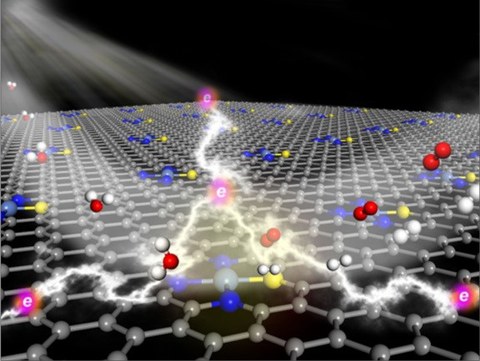10.04.2019
Atomically Dispersed Nickel–Nitrogen–Sulfur Species Anchored on Porous Carbon Nanosheets for Water Oxidation
Exploring earth-abundant, active and stable electrocatalysts to replace noble metal catalysts for oxygen evolution reaction (OER) through alkaline water photoelectrolysis and electrolysis system is a key to develop sustainable energy conversion technologies. Despite certain progress made in the development of heteroatom-doped carbon materials in the past, especially the transitional metal-N (TM–Nx) doped nanocarbons catalysts, the application of TM–Nx-doped nanocarbons in OER electrocatalysis is in infancy, and the overall catalytic performance of TM–Nx-doped nanocarbons is far from satisfactory for practical applications.
Here, Prof. Dr. Xinliang Feng (Technische Universität Dresden, Germany), Prof. Dr. Yang Hou (Zhejiang University, China), and colleagues report a 2D nanocarbon hybrid electrocatalyst comprised of atomically dispersed Ni atoms coordinated with three nitrogen and one sulfur atoms in porous carbon nanosheets (S|NiNx-PC). Benefiting from the abundant porous architecture and well-distributed active sites, the achieved S|NiNx-PC/EG nanosheets electrode displays outstanding electrocatalytic activity and durability for OER with a low overpotential of 1.51 V at 10 mA cm-2 and a small Tafel slope of 45 mV dec-1 in alkaline media. The overpotential for the S|NiNx-PC/EG is the lowest among all heteroatom- and/or transition metal-doped carbon electrocatalysts for OER reported thus far, and it even surpasses the state-of-the-art commercial Ir/C catalyst. Moreover, an integrated photoanode of nanocarbon on a Fe2O3 nanosheet array enables highly active solar-driven oxygen production.
Experimental results reveal that the well-dispersed molecular S|NiNx species act as active sites for catalyzing OER, where the incorporated S atoms can effectively tune the hybridization state of the Ni and N atoms and enhance the electron transfer, thus synergistically promoting the oxidation kinetics. Theoretical calculations manifest that the coordination of Ni–Nx centers hybridized with that of neighboring S atom creates sufficient localized reactive sites by modifying the local charge distribution on the carbon surface and reducing the potential barriers of the elementary reactions, thereby boosting its OER kinetics. More importantly, the accurate atomic structure of isolated Ni atoms coordinated with three N atoms and one S atom in the carbon matrix for the S|NiNx active centers is clearly disclosed by aberration-corrected scanning transmission electron microscopy, atomic electron energy loss spectroscopy and synchrotron radiation X-ray absorption spectroscopy together with DFT-simulated scanning tunneling microscopy. This work was published at Nat. Commun. 2019, doi: 10.1038/s41467-019-09394-5.

